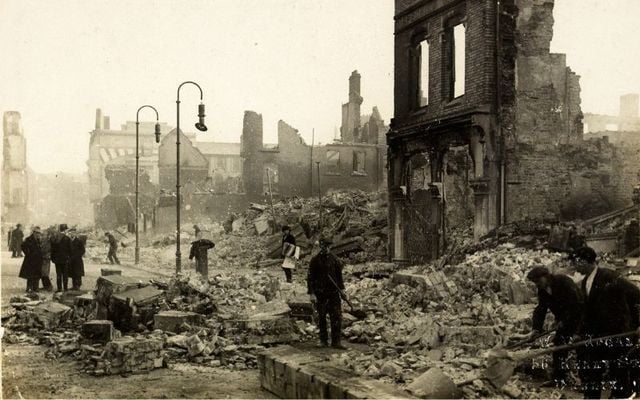In the annals of history, there are moments etched in the collective memory of a nation, events that resonate through time as testaments to the endurance of the human spirit and the destructive forces that can be unleashed upon it.
The Burning of Cork City, a harrowing chapter in the tumultuous history of Ireland, stands as a stark reminder of both the resilience of its people and the ravages of conflict.
In December 1920, during the midst of the Irish War of Independence, Cork, a vibrant and culturally rich city, becomes the epicenter of a devastating conflagration that would forever alter its landscape and the lives of its inhabitants.
This is the gripping tale of that fateful night when flames consumed a city, leaving behind a legacy of destruction, courage, and the unyielding desire for freedom of the Irish people.
It's a night like any other…
The city of Cork, occupied by the British Army, is dotted with military checkpoints. Armed soldiers patrol the streets. A strict military curfew is in place. Any citizen venturing onto the streets past ten o'clock at night risks immediate arrest and possible execution.
North of the city centre, a battalion of the Irish Republican Army lay in wait for a patrol of British Auxiliary soldiers. The Irish Rebels are made up of Volunteers mostly, young men drawn from their jobs as van drivers and butcher's apprentices into a life-or-death struggle with soldiers from the world's most powerful Superpower.
On the other side, the British soldiers (Auxiliaries or Auxies), were drawn from the ranks of the Officer class who'd served in World War l. The Elite troops of the British Army.
The Rebel ambush is triggered as the soldiers leave Victoria Barracks in the city and pass through a place known as Dillion's Cross nearby. The Auxiliary Army troops suffer 12 casualties and a former officer is killed.
It begins…
They say military service is 99% boredom, 1% sheer terror. Whether it's the boredom or sheer terror that overcomes the troops this night, we'll never know. However, the soldiers gather on Patrick's Street, Cork's main retail Street.
All of a sudden, a soldier throws a firebomb into the Munster Arcade, one of the grandest buildings on this old thoroughfare in the city centre.
As the building goes up in flames, the fires rise and smoke billows. The firestarters are overcome with anger. They quickly turn their ire on the City Hall. The venerable Cork building is blown up; Cork's Carnegie Library goes up in flames and most of the city's public records are lost forever.
Ash and soot blacken the air, the smell of burning wood fills the nostrils of the populace, the sound of breaking glass from local shops looted by the drunken soldiers can be heard in the night. The heat from the fire permeates the night.

Love Irish history? Share your favorite stories with other history buffs in the IrishCentral History Facebook group.
The firemen's agonising choice
As flames start to consume the city centre, the firemen are left with a deadly choice - save the city and risk their lives or stand down into safety and let the city burn.
The brave firefighters charge into the city without a thought for their own safety.
The drunken soldiers focus their fury on these stubborn heroes. The Army cut their water hoses with their knives and open fire on the unfortunate firemen. One fireman is treated for serious gunshot wounds.
The cost
The city lies in ashes, a bombed shell of its former glory. The people of Cork count the cost.
Over 2,000 have lost their livelihoods, 5 acres of the city - burned to the ground, £3,000,000 pounds (around $170 million in today's dollars) worth of damage is inflicted on the city.
It's December 1920, a cold winter has descended on the city of Cork. Many are left homeless, jobless with families to feed. They'll have to wait 15 years to see the city recover and be completely rebuilt.
The Aftermath
Embarrassed by the incident, the British government release a statement that the Irish Rebels set fire to their own city.
As the foreign press descend on the city to photograph and report on the destruction, it's apparent to all that the destruction was caused by the British Army and Crown Police.
A court of military enquiry is held and the occupiers state whoever caused the trouble will be held responsible. The enquiry however is indecisive and ultimately no-one is ultimately held responsible for the destruction of the City.
*Dara Burke is a local storyteller and True. Cork. Rebel. When he's not helping guests experience the real 'Rebel City' on his Rebel City Tour of Cork, featuring local food, local drink, and exciting Rebel tales, he's creating guides of things to do in Cork. Join him on his exciting Cork walking tour to immerse yourself in real Cork culture and make the most of your time in the city.
This article was submitted to the IrishCentral contributors network by a member of the global Irish community. To become an IrishCentral contributor click here.




Comments